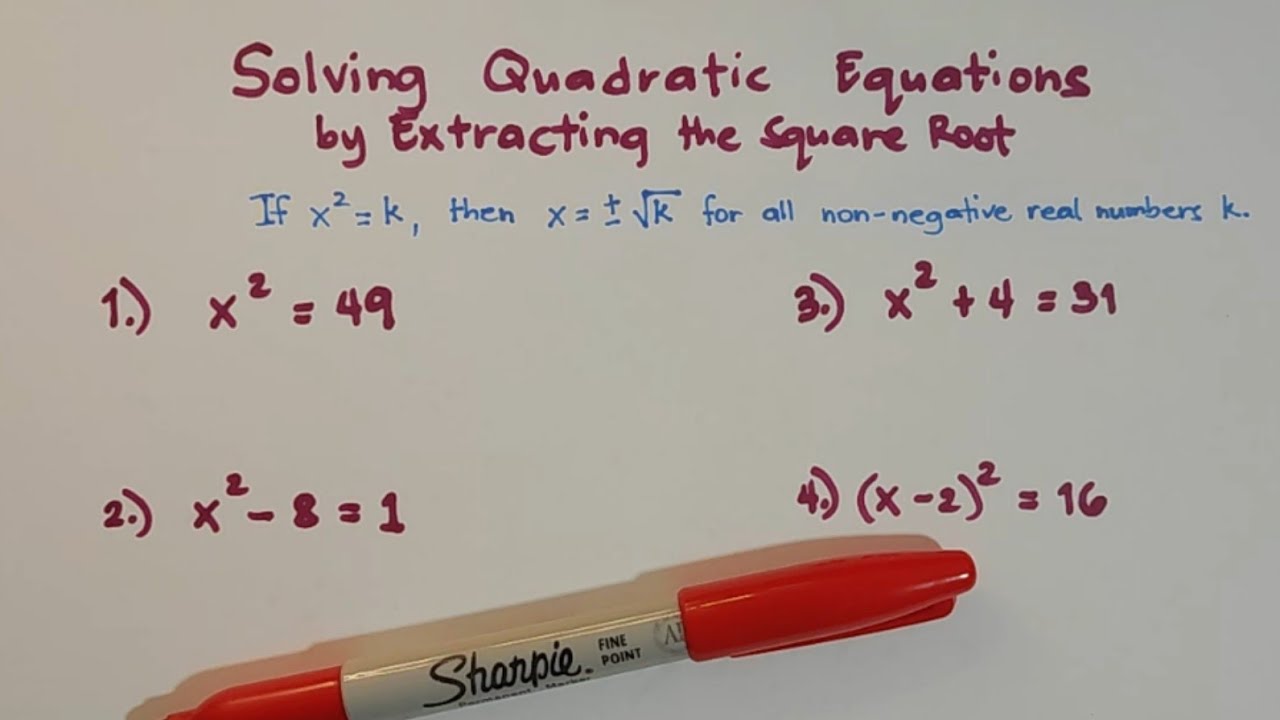2. Ecuaciones cuadráticas completas, solución por el Método de completar el binomio
Summary
TLDRIn this video, Héctor Pérez explains how to solve quadratic equations using the method of completing the square. He walks through the process step by step, demonstrating how to represent quadratic expressions as perfect square trinomials. The video covers essential steps such as moving constants to the other side of the equation, dividing coefficients, adding necessary terms, and factoring into binomials. Pérez also demonstrates two examples with detailed calculations, showcasing both positive and negative roots. The tutorial emphasizes the versatility of completing the square as an alternative method for solving quadratic equations.
Takeaways
- 😀 The method of completing the square is used to solve quadratic equations.
- 😀 A perfect square trinomial can be represented geometrically as a square with side lengths corresponding to terms in the quadratic expression.
- 😀 The first step is to move the constant term to the right side of the equation.
- 😀 The coefficient of x is divided by 2 and squared to complete the square.
- 😀 The square of the halved coefficient is added to both sides of the equation.
- 😀 The equation is then factored into a perfect square trinomial, forming a binomial squared.
- 😀 The square root is taken on both sides of the equation, applying the plus-minus sign.
- 😀 After applying the square root, two possible solutions (roots) for the equation are derived.
- 😀 Completing the square can also be used to solve equations by other methods like graphing, using the quadratic formula, or factoring.
- 😀 For quadratic equations of the form x^2 + bx + c = 0, two roots are typically found: one positive and one negative.
- 😀 The process of completing the square is an alternative method to solve quadratic equations, emphasizing algebraic manipulation and factoring.
Q & A
What is the method being used to solve quadratic equations in this video?
-The method being used is completing the square to solve quadratic equations.
How is the square in the equation represented visually in the explanation?
-The square is represented as a geometric shape, where the sides of the square are equal to 'x', and the area is calculated as 'x * x = x²'.
What is the reasoning behind dividing the coefficient of 'x' by 2 in the completing the square method?
-Dividing the coefficient of 'x' by 2 is necessary to find the value that will complete the square, creating a perfect square trinomial.
What happens to the constant term in the quadratic equation during the solving process?
-The constant term (such as -27 or -45) is moved to the other side of the equation to simplify the expression.
How do you know when to add a term to both sides of the equation?
-You add a term to both sides of the equation after dividing the coefficient of 'x' by 2 and squaring the result, ensuring the equation becomes a perfect square trinomial.
What does it mean to factor a perfect square trinomial?
-Factoring a perfect square trinomial means expressing it as the square of a binomial, for example, (x + 3)².
What is the purpose of taking the square root of both sides of the equation?
-Taking the square root of both sides of the equation helps to isolate 'x' and find the solution to the quadratic equation.
Why do we include the '±' sign when taking the square root of both sides?
-The '±' sign is included because when solving quadratic equations, there are two possible solutions: one positive and one negative.
How do you interpret the two roots in a quadratic equation after completing the square?
-The two roots represent the two possible solutions to the equation, which are the values that satisfy the equation when substituted for 'x'.
Can the method of completing the square be used for all quadratic equations?
-Yes, completing the square can be used for all quadratic equations, although other methods like factoring, graphing, or using the quadratic formula may be simpler in some cases.
Outlines

This section is available to paid users only. Please upgrade to access this part.
Upgrade NowMindmap

This section is available to paid users only. Please upgrade to access this part.
Upgrade NowKeywords

This section is available to paid users only. Please upgrade to access this part.
Upgrade NowHighlights

This section is available to paid users only. Please upgrade to access this part.
Upgrade NowTranscripts

This section is available to paid users only. Please upgrade to access this part.
Upgrade NowBrowse More Related Video

How to Solve Quadratic Equations by Extracting the Square Root? @MathTeacherGon

Persamaan Kuadrat •Part 1: Menyelesaikan Persamaan Kuadrat dengan Pemfaktoran / Faktorisasi Tipe 1&2

3 Cara mudah akar akar persamaan kuadrat

Persamaan Kuadrat • Part 4: Menyelesaikan Persamaan Kuadrat dengan Rumus abc

PERSAMAAN KUADRAT part ZERO-ONE

Akar-akar persamaan kuadrat bagian 2 : Melengkapi kuadrat sempurna
5.0 / 5 (0 votes)